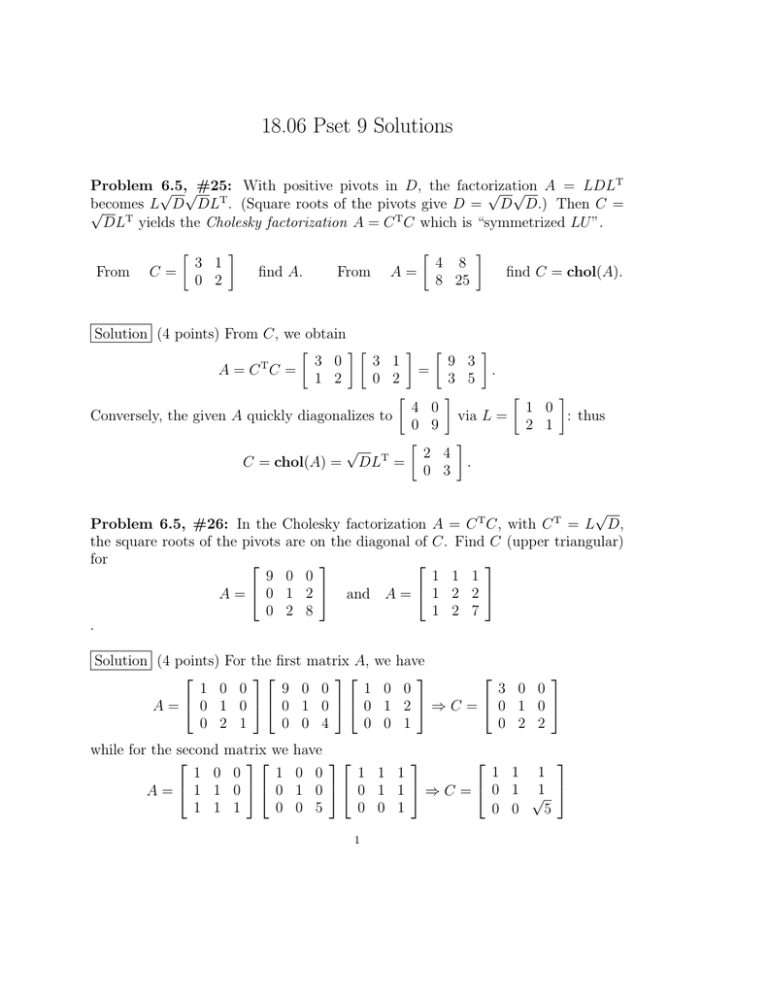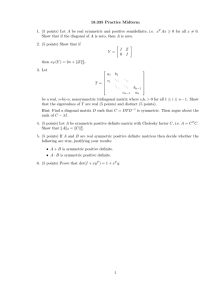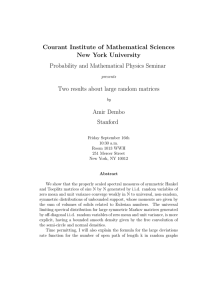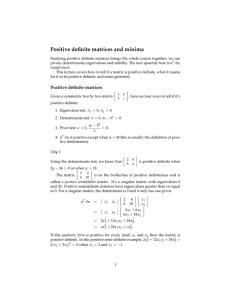Document 13590984
advertisement

18.06 Pset 9 Solutions
Problem √
6.5,√#25: With positive pivots in D, the factorization
A = LDLT
√
√
becomes
L D DLT . (Square roots of the pivots give D = D D.) Then C =
√
DLT yields the Cholesky factorization A = C T C which is “symmetrized LU ”.
�
From
C=
3 1
0 2
�
�
find A.
From
A=
4 8
8 25
�
find C = chol(A).
Solution (4 points) From C, we obtain
�
��
� �
�
3 0
3 1
9 3
T
A=C C=
=
.
1 2
0 2
3 5
�
�
�
�
4 0
1 0
Conversely, the given A quickly diagonalizes to
via L =
: thus
0 9
2 1
�
�
√
2 4
T
C = chol(A) = DL =
.
0 3
Problem 6.5, #26: In the Cholesky factorization
the square roots of the pivots are on the diagonal of
for
⎡
⎤
⎡
9 0 0
A = ⎣ 0 1 2 ⎦ and A = ⎣
0 2 8
.
Solution (4 points) For the first matrix A, we
⎡
⎤⎡
⎤⎡
1 0 0
9 0 0
1 0
A = ⎣ 0 1 0 ⎦⎣ 0 1 0 ⎦⎣ 0 1
0 2 1
0 0 4
0 0
while for the second matrix we
⎡
⎤⎡
1 0 0
1
A = ⎣ 1 1 0 ⎦⎣ 0
1 1 1
0
√
A = C T C, with C T = L D,
C. Find C (upper triangular)
⎤
1 1 1
1 2 2 ⎦
1 2 7
have
⎤
⎡
⎤
0
3 0 0
2 ⎦⇒C=⎣ 0 1 0 ⎦
1
0 2 2
have
⎤⎡
⎤
⎡
⎤
1 1 1
0 0
1 1 1
1 0 ⎦ ⎣ 0 1 1 ⎦ ⇒ C = ⎣ 0 1 √1 ⎦
0 5
0 0 1
0 0
5
1
2
Problem 6.5, #27: The symmetric factorization A = LDLT means that xT Ax =
xT LDLT x:
�
�� �
�
��
��
�� �
�
� a b
�
�
x
1 0
a
0
1 b/a
x
x y
= x y
2
c d
y
b/a 1
0 (ac − b )/a
0 1
y
The left side is ax2 + 2bxy + cy 2 . The right side is a(x + ab y)2 +
pivot completes the square! Test with a = 2, b = 4, c = 10.
y 2 . The second
Solution (4 points) Evaluating out the right side gives ax2 + 2bxy + cy 2 , so the
2
entry in the space given is c − ba , i.e. the second pivot. For the given values, we
have 2x2 + 8xy + 10y 2 = 2(x + 2y)2 + 2y 2 as desired.
Problem 6.5, #29: For F1 (x, y) = x4 /4 + x2 + x2 y + y 2 and F2 (x, y) = x3 + xy − x,
find the second-derivative matrices H1 and H2 :
� 2
�
2
H=
∂ F
∂x2
∂2F
∂y∂x
∂ F
∂x∂y
∂2F
∂y 2
.
H1 is positive-definite so F1 is concave up (= convex). Find the minimum point of
F1 and the the saddle point of F2 (look only where the first derivatives are zero).
Solution (4 points) For F1 (x, y), we first solve for the stationary point
∂F1
∂F1
= x3 + 2x + 2xy = 0,
= x2 + 2y = 0
∂x
∂y
From (2), we have y = −x2 /2. Plug this into (1), we have 2x = 0 and hence the
only critical point is x = y = 0. At this point,
� 2
� �
� �
�
∂ F
∂2F
3x3 + 2 + 2y 2x
2 0
2
∂x
∂x∂y
H1 = ∂ 2 F ∂ 2 F =
=
.
2x
2
0 2
∂y∂x
∂y 2
It is positive definite and hence (0, 0) is a minimal point of F1 (x, y).
REMARK: The problem for F1 = x4 /4 + x2 y + y 2 as originally stated, you get
a curve of minima x2 + 2y = 0, and H1 is only positive semidefinite.
For F2 (x, y), we first solve for the stationary point
∂F2
∂F2
= 3x2 + y − 1 = 0,
=x=0
∂x
∂y
This implies that y = 1. At this point (0, 1),
� 2
� �
� �
�
∂ F
∂2F
6x 1
0 1
2
∂x
∂x∂y
H2 = ∂ 2 F ∂ 2 F =
=
.
1 0
1 0
∂y∂x
∂y 2
3
The eigenvalues of H2 at (0, 1) is the solution to det (H2 − λI) = λ2 − 1, which are
λ1 = 1 and λ2 = −1. They are with opposite signs and hence (0, 1) is a saddle point
of F2 (x, y).
Problem 6.5, #32: A group of nonsingular matrices include AB and A−1 if it
includes A and B. “Products and inverses stay in the group.” Which of these are
groups (as in 2.7.37)? Invent a “subgroup” of two of these groups (not I by itself =
the smallest group).
(a)
(b)
(c)
(d)
(e)
Positive definite symmetric matrices A.
Orthogonal matrices Q.
All exponentials etA of a fixed matrix A.
Matrices P with positive eigenvalues.
Matrices D with determinant 1.
Solution (12 points) First, note that all but the first and fourth are groups�(assum­
�
1 2
ing we are only referring to square matrices in (b)): on the other hand,
2 3
�
�
1 2
and
are both positive definite and symmetric, but their product is not
2 4
symmetric. Intersections of these groups give the simplest examples of subgroups
(for instance, orthogonal matrices with determinant 1, called the special orthogonal
matrices), though there are many others.
Problem 6.5, #33: When A and B are symmetric positive definite, AB might
not even be symmetric. But its eigenvalues are still positive. Start from ABx = λx
and take dot products with Bx. Then prove λ > 0.
Solution (12 points) Taking dot products, we get (ABx)T Bx = (Bx)T A(Bx) on
the left and (λx)T Bx = λxT Bx. Since B is positive definite, xT Bx > 0, and since
A is positive definite, (Bx)T A(Bx) is too (Bx is just another vector). Thus, λ must
be positive as well.
Problem 6.5, #34: Write down the 5 by 5 sine matrix S from Worked Example
6.5 D, containing the eigenvectors of K when n = 5 and h = 1/6. Multiply K times
S to see the five positive eigenvalues.
Their sum should equal the trace 10. Their product should be det K = 6.
4
Solution (12 points) S is the
⎡
√1/2
⎢ 3/2
⎢
S =
⎢
⎢ √1
⎣
3/2
1/2
matrix
√
√
⎤
3/2
1
3/2
1/2
√
√
√
0
3/2
− 3/2 − 3/2 ⎥
⎥
⎥
−1
0
1
0
⎥
√
√
√
√
−√3/2
3/2 −√3/2
3/2 ⎦
1
1/2
− 3/2
− 3/2
√
√
The five eigenvalues (corresponding to the columns) are 2 − 3, 1, 2, 3, and 2 + 3,
which add up to 10 and multiply to 6 as desired.
Problem 6.5, #35: If A has full column rank, and C is positive-definite, show
that AT CA is positive definite.
Solution (12 points) Since C is positive-definite, y T Cy > 0 for any y �= 0 in Rn .
Now, we need to show that z T AT CAz > 0 for any z =
� 0 in Rn . We can rewrite
T T
T
it as z A CAz = (Az) C(Az). Since A has full column rank, N (A) = {0} and in
particular, Az �= 0 in Rn . Therefore, we have (Az)T C(Az) > 0. This implies that
AT CA is positive definite.
Problem 8.1, #3: In the free-free case when AT CA in equation (9) is singular,
add the three equations AT CAu = f to show that we need f1 + f2 + f3 = 0. Find a
solution to AT CAu = f when the forces f = (−1, 0, 1) balance themselves. Find all
solutions!
Solution (4 points) Dot producting our formula with (1, 1, 1) gives
⎡
⎤⎡
⎤
⎡
⎤
c
−c
0
u
f
2
2
1
1
�
�
�
�
1 1 1
⎣
−c2 c2 + c3 −c3 ⎦ ⎣ u2 ⎦ = 1 1 1
⎣
f2 ⎦
0
−c3
c3
u3
f3
0 = f1 + f2 + f3
Substituting f = (−1, 0, 1) gives the two equations c2 (u1 − u2 ) = −1, c3 (u3 − u2 ) = 1
1
−1
(the middle equation is redundant), with a solution (−c−
2 , 0, c3 ). All other solutions
are given by adding multiples of (1, 1, 1), which spans the nullspace.
Problem 8.1, #5: In the fixed-free problem, the matrix A is square and invertible.
We can solve AT y = f separately from Au = e. Do the same for the differential
equation:
Solve
−
dy
= f (x) with y(1) = 0. Graph y(x) if f (x) = 1.
dx
5
Solution
(4 points) y(x)
= −
can graph this.
�
x
1
f (x)dx and if f (x) = 1 then y(x) = 1 − x. You
Problem 8.1, #7: For five springs and four masses with both ends fixed, what are
the matrices A and C and K? With C = I solve Ku = ones(4).
Solution (4 points) The matrices are
⎡
⎤
⎡
1
0
0
0
c1
⎢ −1 1
⎥
⎢
0
0
⎥
c2
⎢
⎢
⎥ , C
=
⎢
0
−1
1
0
c3
A =
⎢
⎢
⎥
⎢
⎣
0
⎦
⎣
0 −1 1
c4
0
0
0 −1
c5
⎡
⎤
c1 + c2 −c2
0
0
⎢ −c2 c2 + c3 −c3
⎥
0
⎥
K =
⎢
⎣
0
−c3 c3 + c4 −c4 ⎦
0
0
−c4 c4 + c5
Inverting K for c1 = · · · = c5 = 1 gives
⎡
⎤
4 3 2 1
1
⎢ 3 6 4 2
⎥
⎥
K −1 = ⎢
5
⎣
2 4 6 3
⎦
1 2 3 4
⎤
⎥
⎥
⎥ ,
⎥
⎦
Multiplying by (1, 1, 1, 1) gives (2, 3, 3, 2).
Problem 8.1, #10: (MATLAB) Find the displacements u(1), . . . , u(100) of 100
masses connected by springs all with c = 1. Each force is f (i) = 0.01. Print graphs
of u with fixed-fixed and fixed-free ends. Note that diag(ones(n, 1), d) is a matrix
with n ones along the diagonal d. This print command will graph a vector u:
plot(u, ‘+’);
xlabel(‘mass number’);
ylabel(‘movement’);
print
Solution (12 points)
>> E = diag(ones(99,1),1);
>> K = 2*eye(100)-E-E’;
>> f = 0.01*ones(100, 1); u = K\f;
>> plot(u,’+’); xlabel(’mass number’); ylabel(’movement’); print
>> K(100,100) = 1; u = K\f;
>> plot(u,’+’); xlabel(’mass number’); ylabel(’movement’); print
6
Figure 1. Fixed-fixed
14
12
movement
10
8
6
4
2
0
0
10
20
30
40
50
60
mass number
70
80
90
100
Problem 8.1, #11: (MATLAB) Chemical engineering has a first derivative of
du/dx from fluid velocity as well as d2 u/dx2 from diffusion. Replace du/dx by
a forward difference, then a centered difference, then a backward difference, with
�x = 18 . Graph your numerical solutions of
−
d2 u
du
+ 10
= 1 with u(0) = u(1) = 0.
2
dx
dx
Solution (12 points)
>> E = diag(ones(6,1),1);
>> K = 64*(2*eye(7) - E - E’);
>> D = 80*(-eye(7)+E);
7
Figure 2. Fixed-free
60
50
movement
40
30
20
10
0
0
10
20
30
>> forward = (K+D)\\ones(7,1)
forward =
0.0125
0.0250
0.0376
0.0496
0.0641
0.0688
0.1125
40
50
60
mass number
70
80
90
100
8
>> backward = (K-D)\\ones(7,1)
backward =
0.0431
0.0554
0.0539
0.0462
0.0359
0.0244
0.0123
>> centered = (K+D/2-D’/2)\\ones(7,1)
centered =
0.0125
0.0250
0.0374
0.0497
0.0613
0.0697
0.0644
>> plot(n,forward(n),n,backward(n),n,centered(n))
9
Figure 3. Overlayed numerical solutions
0.12
0.1
0.08
0.06
0.04
0.02
0
1
2
3
4
5
6
7
MIT OpenCourseWare
http://ocw.mit.edu
18.06 Linear Algebra
Spring 2010
For information about citing these materials or our Terms of Use, visit: http://ocw.mit.edu/terms.







